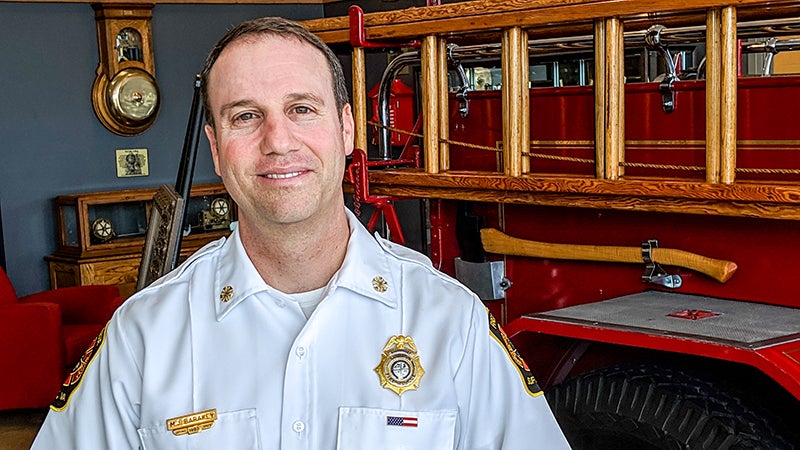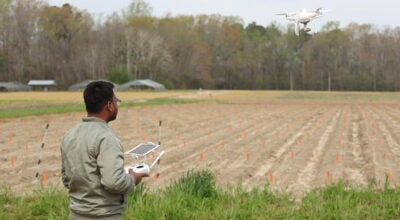Fire chief settles in, outlines vision
Published 10:06 pm Friday, March 8, 2019

- Suffolk fire chief Michael Barakey, since starting in the position last October, has been putting together a vision for the Suffolk Fire and Rescue Department.
When Suffolk City Manager Patrick Roberts announced the hire of Michael Barakey as the city’s new fire chief last September, he noted how prepared Barakey was to take on the city’s increasing challenges, especially when it comes to its growth.
With the fire chief into his sixth month on the job, Roberts feels no different.
“Chief Barakey is doing a great job, and his arrival has been a seamless transition of leadership in the Suffolk Fire and Rescue Department,” Roberts said. “As Suffolk is a growing community with some unique challenges due to our size in terms of land area, Chief Barakey provides a wealth of insight that will help the department grow and keep pace with the city’s growing public safety needs.”
Barakey said the Suffolk Fire and Rescue Department is an open canvas, and the city is filled with opportunity as it grows.
“This fire department, right now, obviously, is a fantastic fire department. It does operations and services extremely well, but where will the fire department or the city be in five years, or 10 years? I want to be a part of the development of this organization and its growth and making this fire department thrive.”
Call volumes — the number of 911 calls answered by Suffolk Fire and Rescue — have increased by 21.4 percent from the 11,446 calls for service in 2013 to 13,898 calls in 2017.
Barakey said his career has prepared him to be at this point. He has both administrative and field experience, and has commanded numerous major incidents, including hurricanes and earthquakes and the 2002 Salt Lake City Olympics, as a task force leader on a National Urban Search and Rescue Team.
“Everything I’ve done professionally, I believe, has allowed me the opportunity to be a metropolitan fire chief,” Barakey said. “And the city of Suffolk right now is there, just south of 100,000 people.”
He cited his preparation working in fire departments in Chesapeake and Virginia Beach, in particular, when he was tapped for a new administrative role in Virginia Beach in agency accreditation, later becoming a peer assessor to review other fire departments.
Barakey, who was a district chief in Virginia Beach before coming to Suffolk, said he learned a lot about Hampton Roads’ and the nation’s fire service, by expanding his view of how fire departments fit in with city, state and federal governments.
That gives him a big-picture vision of where he wants to see the Suffolk Fire and Rescue Department go.
That vision includes:
- International accreditation for the Suffolk Fire and Rescue Department within three years
- Filling staffing vacancies
- Adding staff to the Fire Prevention Bureau
- Developing a fire training facility in Suffolk
- A new College Drive fire station
- Developing joint training with operational medical director Dr. Carl Wentzel on community medicine
- Implementing a mental wellness initiative for staff and their families
- Expanding regionalism efforts
International accreditation, he said, brings a measure of validity to the department.
“I think it solidifies where the fire and rescue department’s vision meets with that of the city’s, because being an internationally accredited fire department isn’t about fire and rescue, and ambulances and fire trucks,” Barakey said. “It’s about how we fit into the core services of the community.”
The other parts of his vision relate to the accreditation, he said, because by having the other components in place, it strengthens the department and gives it a stronger case for that accreditation.
Barakey said he is concerned about staffing levels that show the department with 44 vacancies before starting the most recent recruit academy. Last Tuesday, the academy began with 37 people.
“This is just trying to get us up to staffing levels,” Barakey said. “So this is huge for me as a chief to not only maintain staffing at about level, but it’s to run these recruit academies often enough to meet the demands of retirements.”
The process to onboard new hires takes about one year, he said, between background checks, references and ability testing. Those new hires are in the academy for eight months.
Barakey also wants to add six more people to look at preventing incidents. Currently, the Fire Prevention Bureau has five people who can only do prevention activities at large businesses.
“I know an initiative that needs to be done is to try to prevent the fire from ever occurring, let alone suppressing it when it’s ongoing,” Barakey said.
Key to that, he said, is getting Suffolk its own fire training facility, also known as a burn building. The closest ones are on the property of the St. Juliens Creek Annex along the Portsmouth and Chesapeake border and another in Franklin.
“I’m working with the (city) manager on trying to identify land to develop, and this is going to be phased — this is three to five years away,” Barakey said.
For the busy northern part of Suffolk, he’s eyeing the planned, $7.5-million College Drive fire station, part of the city’s current Capital Improvements Plan.
At Station 5 on Bridge Road, four units responded to 5,099 calls for service in 2017, and though it’s meeting the demands, Barakey said now is the time to plan ahead for growth.
“We’re OK in the fact that we have two engine companies, a ladder company and an ambulance out there, so we have four pieces of apparatus plus a battalion chief, so we’re meeting those demands,” Barakey said, “but although they’re stretching us up there, it’s in line perfectly with the growth of the city.”
One of what he terms his more futuristic and visionary goals is to establish a community medicine program to help people who may not need an emergency room, but still need care after making a call to 911.
And in terms of dealing with the toll of professional trauma, Barakey wants to have physically and mentally healthy fire and rescue staff, and the department has embarked on a training known as Stress First Aid. It will eventually be rolled out to family members, he said.
On a regional front, Barakey has started automatic aid discussions with Portsmouth and Chesapeake, working with information technology directors, communications and 911 dispatching to make responses to calls along the borders more seamless. He’s also working with the Virginia Port Authority to increase resources for responses on the James and Nansemond rivers.
Barakey, in having a vision for the department, said he wouldn’t be able to do it without a capable staff, and without those who have gone before him.
“I think we’re only as good as the total of the whole, and I think the whole in this organization is so strong that these visions … are the visions of my deputies, are the visions of the captains, and the lieutenants and the battalions, and they’re not mine,” Barakey said.






